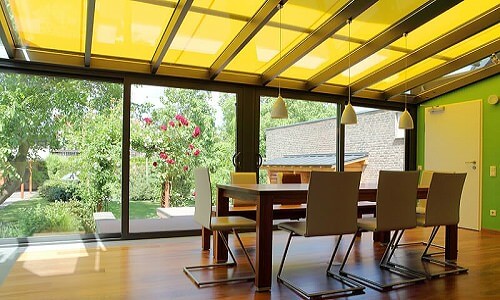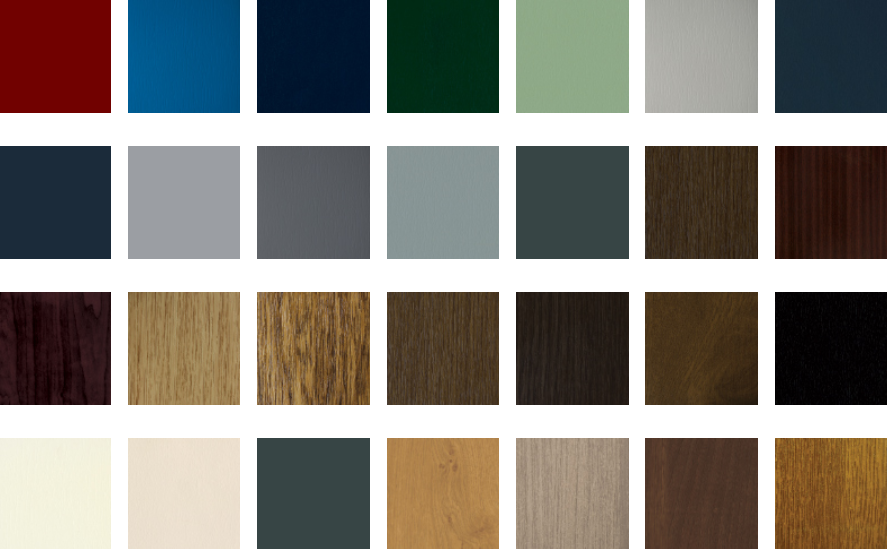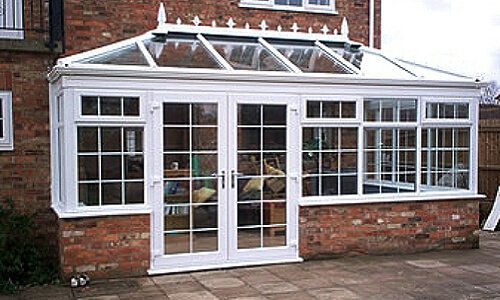Lean to Conservatories:
What are the options for Lean to conservatory designs and how much do lean to conservatories cost?
 A lean to conservatory works well as either a large, medium or small conservatory home extension. The basic rectangular or square shape, and uncomplicated single sided roof, has kept this design a favourite of homeowners for many years.
A lean to conservatory works well as either a large, medium or small conservatory home extension. The basic rectangular or square shape, and uncomplicated single sided roof, has kept this design a favourite of homeowners for many years.
Whilst sometimes you can see this style of conservatory referred to as a Mediterranean sunroom, a lean to conservatory may have a fairly basic overall shape, and a low angled sloping roof, but that does not mean that they are unattractive.
With so many options for lean to conservatories in the market, they are well worth considering for any home extension.
There is also the cost factor to take into consideration. There are many suppliers where you can find examples of quite cheap lean to conservatories in the market.
Fully fitted prices for a 3×3 lean-to conservatory can range from around £6,000 to £8,000.
In this guide you will find sections covering:
- Lean to design options.
- Optional features for your conservatory.
- Quick guide to lean to conservatory prices.
So, what are the options available, and what kind of price ranges are there for a Lean to conservatory?
Popular Lean to designs.
Broadly, there are 3 or 4 popular visual styles in the market:
- Full height glass on all 3 sides.
- Glass sides with low level walls (Dwarf walls).
- The longer side glazed full height and the shorter sides solid.
You also have the most common conservatory roof options which are:
- Full glass (double glazed)
- Tiled – classic slate, concrete, synthetic or even metal.
- Polycarbonate sheets (twin or triple wall panels are better suited).
- Composite panels.
The 3 primary materials used in the construction of the frames for a lean to conservatory.
- UPVC: An energy efficient, relatively low priced material that is used in a very high proportion of lean to conservatories. It requires very little maintenance, lasts a very long time and can be manufactured in a range of different colours.
- Aluminium: Making a welcome comeback, this very strong & lightweight material is ideal for use in a conservatory. Modern aluminium profiles don’t corrode like the old days and the finished surfaces are superb. Available in over 150 colours.
- Timber: A hardwood lean-to conservatory is a classy home extension. Many believe you just can’t beat real timber, and in the case of a modern timber conservatory, it would be hard to argue. Hardwood is strong and durable, looked after, can last almost forever. Timber is naturally a good insulator.
Apart from the general size of your extension, the way you combine the above features will have a considerable impact on cost.
In general, the more glass you use, the less complex the construction process and the lower the resulting cost.
The cheapest lean-to design will be one that has full glass sides and a polycarbonate roof. The most expensive will have a tiled roof with sides that feature a considerable amount of solid walling.
It’s a simple matter of the labour and raw materials adding expense for the more complex designs.
Of the 3 materials, UPVC is generally the less expensive to use, with Hardwood and Aluminium relatively costlier.
Here is an example of relative Lean to conservatory prices based on different frame materials:
Compare Quotes
More about lean to conservatory designs
There are 2 rather nice variations on the lean to theme for medium sized conservatory extensions, and 3 more for large conservatories:
Small conservatories.
The so-called Veranda conservatory is based on the lean to. This is where the roof has been extended past the edge of the walls, usually on the widest side. The roof extension creates a protected area or Veranda. Glass sides can also be added to act as “windbreakers”, creating an even more pleasant.
A Gull-wing lean-to conservatory has a subtly different shape. In this case, the corners of the conservatory look like they are “cut-off”. The single 90-degree corner is switched for two 45-degree angles, which creates a faceted look somewhat reminiscent of a Victorian conservatory.
This has the side effect of making the roof more complex, and therefore making it costlier, than a regular lean to extension.
Large conservatories.
- T-shaped lean to conservatories are suitable for larger extensions. This design looks similar like a capital letter T, but with the top of the T wider and the upright “leg” shorter. The wide section is usually a lean-to section and the centre section using a Gable, Pavilion or even Victorian designs.
- L-shape Conservatories are often used to wrap around a corner or fit into a corner. But can also be an alternative to a P-shape conservatory. An L-shape conservatory is typically 2 lean to sections connected at right angles to each other.
- P-shape conservatories are a combination of lean to and Victorian styles. Basically, the Victorian section is added to one end of the lean-to, in order to form the curved part of the P.
Optional design features for your conservatory.
A little bit of personalisation goes a long way.
Matching, or contrasting, the overall look of your home is clearly a matter of personal preference, but what type of things can you do with your lean-to conservatory to make your room stand out from the crowd?
Roofing.
The main choices are to either use a clear or solid roof, but it’s also becoming quite trendy to go for a hybrid of both. This is sometimes best achieved by using composite paneling or lightweight synthetic roof tiles.
With a tiled lean to conservatory roof, there are loads of different coverings in terms of colour, material and sizes of roof tiles.
- Standard concrete roof tiles
- Slate
- Metal roof tiles
- Synthetic roof tiles
All of these roof tiles come in different price ranges and some are very light-weight, such as metal or synthetic or even recycled synthetic roof tiles. Tapco tile do a great range of synthetic tiles, whilst Metro & Supalite offer some very nice metal roof tiles:
http://www.tapcoroofingproducts.com/product/tapcoslate-classic/
Not only can you decide upon the type of covering, you could also experiment with the direction of the roof slope. A regular lean-to conservatory has the roof slope running downwards away from the property.
However, you will now see more examples of the roof slope being rotated to the left, right or even reversed. Rotating the slope of the roof can make a dramatic impact on the overall look of your home extension.
Choosing Your Conservatory Doors
The type of door fitted can also be of influence, both in terms of appearance and convenience of use.
Fitting inwards opening French Doors is not a good idea for a small conservatory and maybe sliding doors would not give you the best result here either. But opening outwards French doors or Bifold doors can make it easy to get in and out of a small conservatory – they also don’t take up any internal space.
Inline sliding doors work better when there is plenty of width to work with. The smallest recommended width for a sliding patio door would be around 1600mm to 1900mm. French doors can go down in size to around 1000mm.
If you are lucky enough to have a large wide conservatory, then bifolds are splendid doors to fit. If you run them the full width of the room, when you open them fully, it’s like you have completely taken the wall away and your extension is totally open to your outside area.
Solid Walls in a conservatory.
It’s an option chosen by many homeowners to use solid walling of some type in their lean to conservatory design.
Dwarf walls are a common site in many conservatories, and so is a solid block or brick full height wall on one, or both, sides. However, the walling needs to be double skinned with a cavity and that extra material and labour can add quite a healthy amount to the cost of a lean to conservatory.
For a 3000 mm x 2500 mm, dwarf walling can add at around £1,000 to £1,500 to the price.
Coloured Lean to Conservatories.
With a wooden conservatory, obviously, you can paint it or stain it any colour you like. With Aluminium or UPVC lean to conservatories you might think you have a more limited choice, but actually there is quite an extensive range of colours that you could go for.
There are 2 types of methods used to colour UPVC and Aluminium conservatory extensions and those are:
- Colour Foils: When you see the word foil, it might conjure up a picture of some leftover food wrapped in silver in your mind. Actually you would not be too far off the mark. In effect a coloured film, or foil, is actually wrapped around the frame profiles and then baked on under pressure and high temperature. This permanently bonds the colour to the profiles, giving a long lasting, peel & crack free, painted finished surface. The foil can also bond a textured surface onto the frames to give a wood-grain surface. Used a lot for coloured UPVC with a range of around 20 colours.
- Spray Paints: Most often used with Aluminium are RAL* spray paints. These are powder coated paint finishes which are baked onto the surface of metal creating a permanent bond. The range of RAL colours is huge, going up to around 200. Also available with wood-grain surfaces.
*(RAL is an abbreviation of Reichs-Ausschuss für Lieferbedingungen. The system was developed by the German Standards Commission around 1925).
As you might expect, the “standard issue” colour for conservatory frame profiles is white. If you want to add a colour it is likely to bump up the cost of the frames (not the whole conservatory) by about 15% to 20%.
So bear in mind, that if you want a coloured UPVC or Aluminium conservatory, you will need a bigger budget than that for a standard white room.
Compare QuotesWhat kind of colours are available?
As briefly mentioned beforehand, UPVC colours range up to about 20, plus timber grain finishes, plus options for dual colours, where you can have a different colour inside to the one outside.
For Aluminium, with RAL powder coats, you should easily be able to find 100 different colours, with the full range going up to around 200. Both will dependent on availability from your chosen supplier / installer.
Maintaining Energy Efficiency.
How energy efficient your lean-to conservatory is will depend upon the type of glazing you fit. Opting for a solid roof is definitely going to make your room more energy efficient than one with a polycarbonate roof, but your initial investment is going to be higher.
However, the roof of your conservatory is a big factor when keeping the room at an even temperature. The additional initial investment, in our humble opinion, is going to to worth it just by making the room more “user friendly”. Many owners of conservatories with polycarbonate roofing will tell you sad stories of how cold i their conservatory gets in the winter and how hot it gets in the summer – a tiled roof will eliminate these extremes and allow you and your family to enjoy the room 365 days per year.
A regular conservatory is going to be around 70% glazed and it is here where you can save, or lose the most energy.
Everybody knows that double glazing is made from 2 sheets of glass separated by an air gap. But you may not be aware that you can vary the width of that air gap and even substitute the air inside it for an inert gas that reduces heat transfer even further.
It is important to know the size of sealed double glazed units that are on offer, here are examples showing “glass – air gap – glass” dimensions:
- 14mm (4-6-4)
- 16mm (4-8-4)
- 18mm (4-10-4)
- 20mm (4-12-4)
- 22mm (4-14-4)
- 24mm (4-16-4)
- 28mm (4-20-4)
The most energy efficient are the 28mm sealed units (made from 4mm glass – 20mm gap – 4mm glass). If you fill the gap with Argon gas the efficiency goes even higher. 20mm double glazed units are probably the average size fitted.
A Quick Guide to Lean to Conservatory Prices.
For any given size of lean to conservatory, how you combine all the features referred to previously in this article, will have an impact on the final cost of your home extension.
As we illustrated, UPVC conservatories can very often be the cheapest. It can be misleading to judge on headline prices, as neither a high price or a low price guarantee the level of quality.
Our suggestion, alongside that of many consumer associations, is that you collect at least 3 or 4 written quotes to compare what is on offer before coming to a buying decision.















